New Reality Tiler Optimizes 3D Tiles for Photogrammetry and Reality Models
Today, we’re announcing the new Reality Tiler for 3D photogrammetry and reality models as part of 3D Tiling Pipelines included in Cesium ion and on-premises products.
The 3D geospatial community has seen explosive growth in the capture, processing, streaming, and consumption of 3D models derived from photogrammetry and reality scans. Because users are capturing higher resolution data more frequently than ever before, our 3D Tiling Pipeline is engineered to produce the most optimized 3D tilesets for streaming, runtime visualization, and analytics.
With thanks to the user community and industry partners who contributed feedback, here are the major features updates:
The new Reality Tiler is designed to scale for massive 3D photogrammetry models and improves robustness and error reporting. It takes advantage of multi-core parallelism, out-of-core memory management, and other computer graphics research to scale massive reality models and optimize 3D tilesets. The Reality Tiler decreases the tileset size, and improves tiling speed, runtime load latency, and visual quality compared to the existing 3D Model Tiler.
| Source Data | Tiler | Tileset Size | Tiling Time | Avg. Load Time |
|---|---|---|---|---|
| AGI HQ | 3D Model Tiler | 36 MB | 1:45 | 1.48s |
| Reality Tiler | 61 MB | 0:52 | 2.54s | |
| Osaka | 3D Model Tiler | 4.3 GB | 26:02 | 4.64s |
| Reality Tiler | 1.74 GB | 26:08 | 3.97s | |
| Discovery Space Shuttle | 3D Model Tiler | 1.7 GB | 17:00:00 | 4.36s |
| Reality Tiler | 1.61 GB | 1:31:39 | 2.37s |
Performance comparison between 3D Model Tiler and new Reality Tiler. There may be some variations depending on the source data and model characteristics.
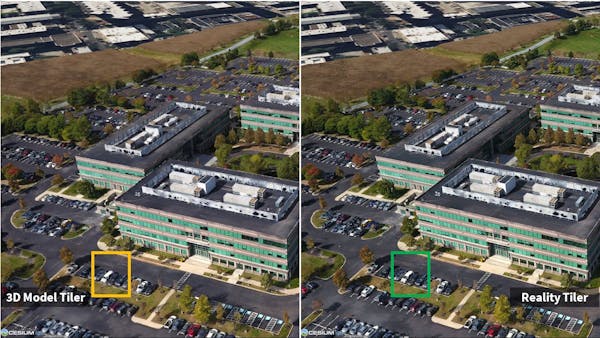
Visual Comparison between 3D Model Tiler (Left) and the new Reality Tiler (Right). AGI HQ.
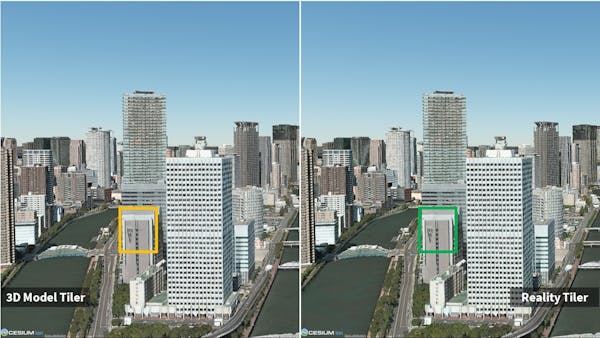
Visual Comparison between 3D Model Tiler (Left) and the new Reality Tiler (Right). Osaka, Japan.

Visual Comparison between 3D Model Tiler (Left) and the new Reality Tiler (Right). Space Shuttle Discovery.
The 3D Tiles 1.1 specification is designed for streaming high-resolution, semantically-rich 3D geospatial data to the metaverse. 3D Tiles 1.1 added Implicit Tiling for improved analytics and random access to tiles and several glTF extensions for fine-grained metadata storage.
The Reality Tiler uses Implicit Tiling and glTF extensions to optimize 3D tilesets. Implicit tiling enables random access to any tile, or any number of tiles needed to display or analyze a region. This is useful for large-scale simulations or analytics based on spatial queries or ray marching. It also enables future capabilities like streamlined partial updates to a subset of a 3D tileset.
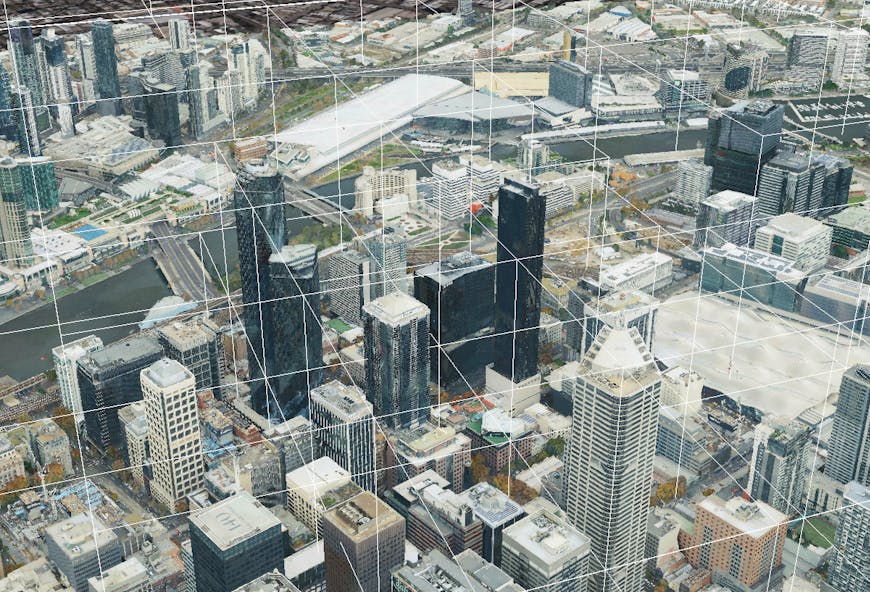
Implicit Tiling produces predefined levels of detail and bounding volumes in the tileset which can be randomly accessed. Runtime engines can select the best tiles faster for any given view or analytics.
KTX 2.0 is a glTF extension that enables compressed textures for transmission and runtime use across GPU vendors, reducing GPU memory, bandwidth, and power usage. The Reality Tiler uses KTX 2.0 with ETC1S compression which decreases the texture storage in 3D tilesets by 10-30%, improves loading time by an average of 30%, and decreases runtime GPU memory usage by over 80% compared to 3D tilesets with JPEG textures, while maintaining comparable visual quality. Tiles stream and load faster, while consuming less memory, allowing you to optionally increase the level of detail. KTX 2.0 compression is enabled by default on Cesium ion for all models processed by Reality Tiler. All Cesium runtime engines already support KTX 2.0 to ensure cross-platform functionality.
In addition to KTX 2.0 Texture Compression, the Reality Tiler includes Draco compression for meshes and also adds support for Meshopt compression.
| Tileset Size | GPU Texture Memory | Avg. Load Time per Tile | ||
|---|---|---|---|---|
| Melbourne | JPEG | 7.73 GB | 2200 MB | 199 ms |
| KTX 2.0 | 3.21 GB (58.47% reduction) | 219 MB (90% reduction) | 46 ms (76% faster) | |
| AGI HQ | JPEG | 68 MB | 187 MB | 19.596 ms |
| KTX 2.0 | 61 MB (10% reduction) | 24 MB (87% reduction) | 19.014 ms (3% faster) | |
| Osaka | JPEG | 2.58 GB | 484 MB | 24.364 ms |
| KTX 2.0 | 1.74 GB (32% reduction) | 64 MB (86% reduction) | 19.929 ms (18% faster) | |
| Discovery Space Shuttle | JPEG | 2.25 GB | 696 MB | 28.756 ms |
| KTX 2.0 | 1.61 GB (28% reduction) | 127 MB (81% reduction) | 19.769 ms (31% faster) |
Tileset Size, GPU Memory, and Load Time Comparison between 3D Tiles 1.1 tilesets using JPEG and KTX 2.0. Runtime usage measured using CesiumJS 1.110.

Visual comparison between 3D Tiles 1.1 tilesets using JPEG (Left) and KTX 2.0 (Right). Visual quality is preserved when using KTX 2.0 compression.

Visual comparison between 3D Tiles 1.1 tilesets using JPEG (Left) and KTX 2.0 (Right). Visual quality is preserved when using KTX 2.0 compression.
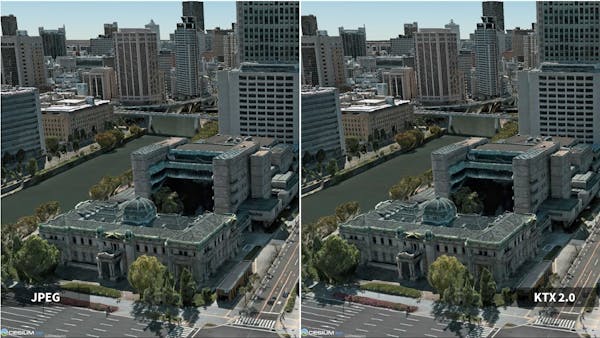
Visual comparison between 3D Tiles 1.1 tilesets using JPEG (Left) and KTX 2.0 (Right). Visual quality is preserved when using KTX 2.0 compression.
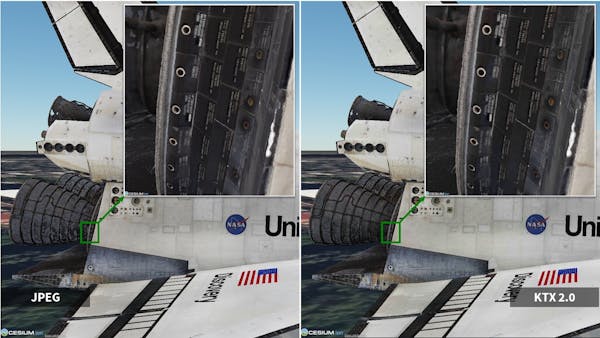
Visual comparison between 3D Tiles 1.1 tilesets using JPEG (Left) and KTX 2.0 (Right). Visual quality is preserved when using KTX 2.0 compression.
One of the most requested features is support for coordinate reference system information built into the 3D meshes. Previously, models were tiled in local coordinates, which could then be positioned using the 3D geolocating tool on Cesium ion.
The Reality Tiler can convert known projection systems to WGS84 so that they are accurately positioned in a global reference system. Coordinate Reference System support is available to on-premises users at launch as we work to enable this in Cesium ion. Support for projection information in metadata files from various photogrammetry and reality mesh software tools is also on the roadmap.
The new Reality Tiler will be the default for all 3D Capture / Reality Model / Photogrammetry data types. By default, the tileset will be tiled with KTX 2.0 texture compression and Draco geometry compression.
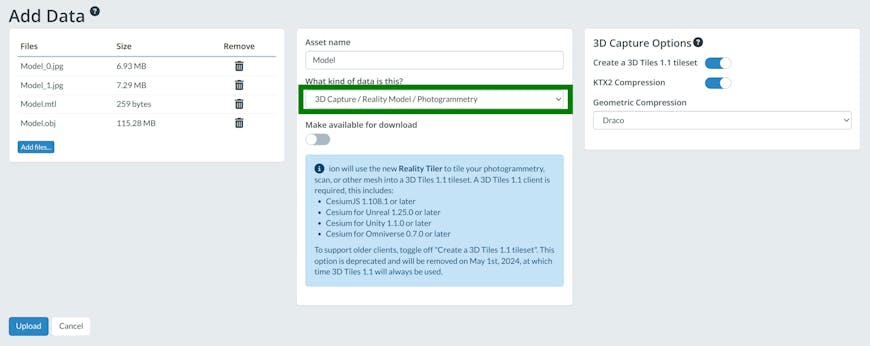
If you are using the Cesium ion REST API to upload your models, you will need to set the sourceType to 3D_CAPTURE with targetVersion to 1.1. Set the geometryCompression to DRACO (default) and set textureFormat to KTX2. For more details, refer to the create a new asset documentation.
We’re excited to share this release with the Cesium community. As we further improve and optimize the pipeline, we’d like your input to help focus our efforts.
- Support for Rich Semantic Metadata using 3D Tiles 1.1: AI-generated semantic metadata is aiding in better decision making and analytics. Preserving and generating semantic metadata information in 3D tilesets can be used for visual styling, autonomous simulation, training, and more.
- Improve coordinate system and metadata support: The automatic parsing of projection information in sidecar files that are often included in 3D Photogrammetry and reality modeling software.
- Upgrade path in Cesium ion and Cesium ion on-premises: We’re exploring mechanisms to allow users to upgrade 3D Tiles 1.0 tilesets to 3D Tiles 1.1.
We welcome feedback and feature requests to support your photogrammetry use cases on the Cesium Community Forum.
Try out the new Reality Tiler on Cesium ion today.